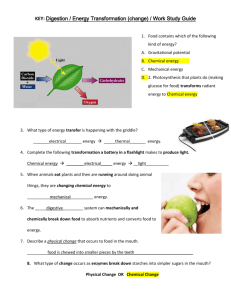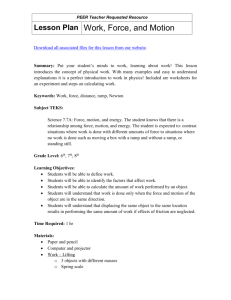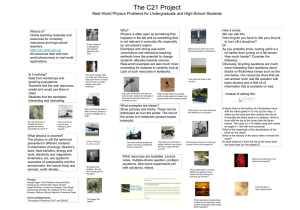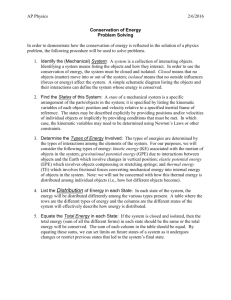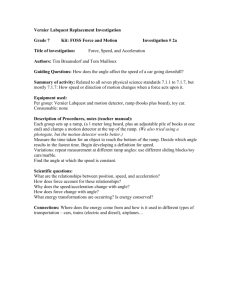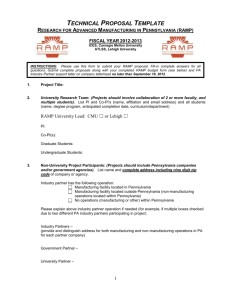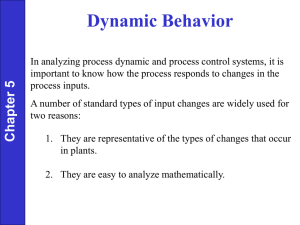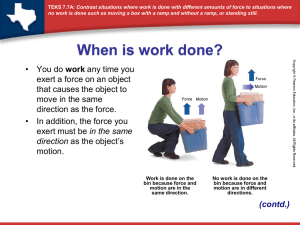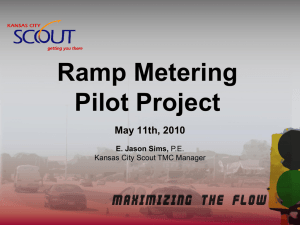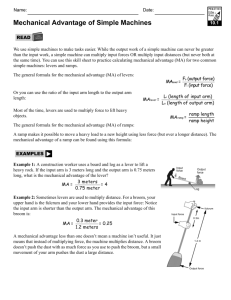Work and the Human Body Lab
advertisement
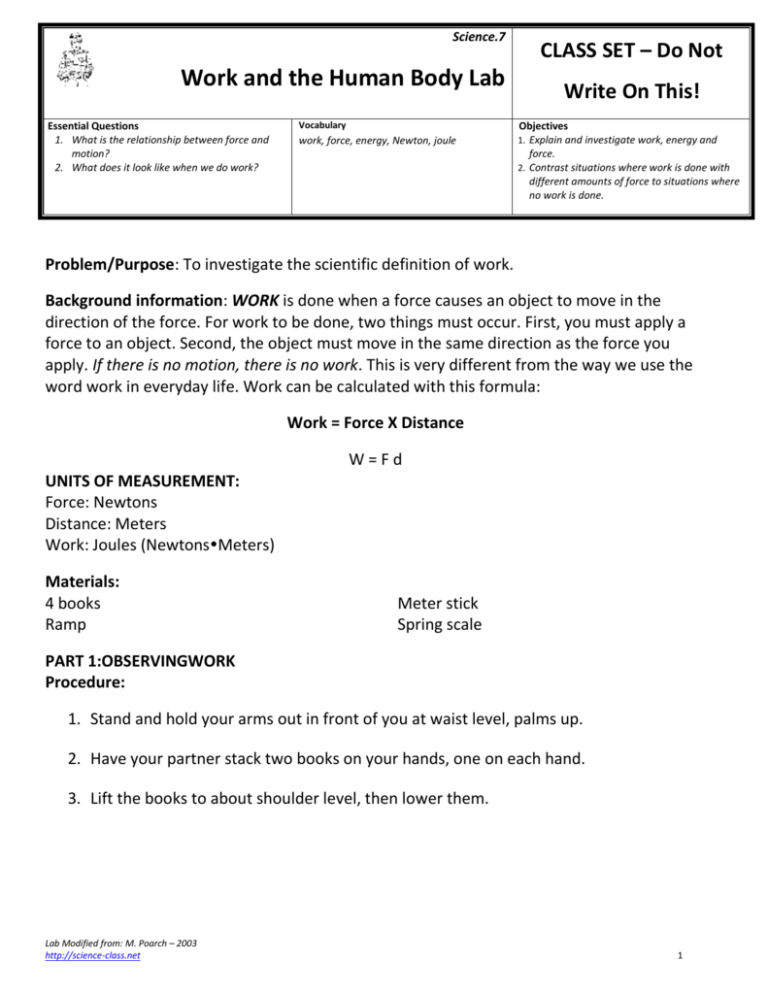
Science.7 CLASS SET – Do Not Work and the Human Body Lab Essential Questions 1. What is the relationship between force and motion? 2. What does it look like when we do work? Write On This! Vocabulary Objectives work, force, energy, Newton, joule 1. Explain and investigate work, energy and force. 2. Contrast situations where work is done with different amounts of force to situations where no work is done. Problem/Purpose: To investigate the scientific definition of work. Background information: WORK is done when a force causes an object to move in the direction of the force. For work to be done, two things must occur. First, you must apply a force to an object. Second, the object must move in the same direction as the force you apply. If there is no motion, there is no work. This is very different from the way we use the word work in everyday life. Work can be calculated with this formula: Work = Force X Distance W=Fd UNITS OF MEASUREMENT: Force: Newtons Distance: Meters Work: Joules (NewtonsMeters) Materials: 4 books Ramp Meter stick Spring scale PART 1:OBSERVINGWORK Procedure: 1. Stand and hold your arms out in front of you at waist level, palms up. 2. Have your partner stack two books on your hands, one on each hand. 3. Lift the books to about shoulder level, then lower them. Lab Modified from: M. Poarch – 2003 http://science-class.net 1 4. Now try raising them overhead. When your hands are overhead, are you working harder than when you raised them to shoulder level? Describe your observations in your ISN, using complete sentences 5. Lower the books again. Have your partner put two more books on each of your hands, so you’re holding four books. Try to raise them to shoulder level. Are you pushing harder (using more force) than when you were holding only two books? Describe your observations in your ISN, using complete sentences 6. Hold the four books at shoulder level until your arms get tired. Are you exerting force? Do you think you are doing work in these situations? What is the work being done on? Describe your observations in your ISN, using complete sentences Have your teacher check your answers please. Lab Modified from: M. Poarch – 2003 http://science-class.net 2 Science.7 Work and the Human Body Lab Name ___________________________ Date ____________________________ PART 2: UNITS OF MEASUREMENT: Force: Newtons Distance: Meters Work: Joules (NewtonsMeters) Materials: 4 books Ramp String Spring scale Meter stick Question: What affect will the steepness of a ramp have on work? Hypothesis: Independent Variable: Dependent Variable: Controls: Procedure: 1. Set up the provided ramp flat on the table top. Loop the string around a book, and hook this to the spring scale. Slowly and evenly, drag the book down the ramp. Try to keep the measurement of force on the spring scale steady. Record the amount of force used in the data table. 2. Use the ruler to measure how tall the ramp is (it is the height of the ramp itself), record this in the data table. Careful to record this in METERS. (remember 100 cm = 1m) 3. Find out how much work you did by using the formula: work = force x distance. Record your answer on your data table. 4. Repeat steps 1-3, but add one textbook each time to the end of the ramp, to increase the incline of the ramp. Lab Modified from: M. Poarch – 2003 http://science-class.net 3 Data Table: Calculations of Work (Work = Force x Distance or W = F x D) Object Force (N) Height of Ramp (m) Work (J) Flat = Textbook 1 textbook = Textbook 2 textbooks = Textbook 3 textbooks = Textbook Conclude and Apply 1. As the ramp was made steeper, what happened to the force required to pull the book up? How did this affect the work? 2. Was your hypothesis accepted or rejected? 3. A boy lifts a 30N desk 2 meters above the ground. How much work did the boy do on the desk? Show your work. 4. Suppose you want to calculate how much work it takes to lift a 160 N barbell. Besides the mass of the barbell, what other information do you need to know? 5. A 45N girl sits on a 8N bench. How much work is done on the bench? Show your work. 6. CHALLENGE: Identify 3 body systems directly involved doing the kind of work we did in this lab. Explain how each was involved. Lab Modified from: M. Poarch – 2003 http://science-class.net 4
